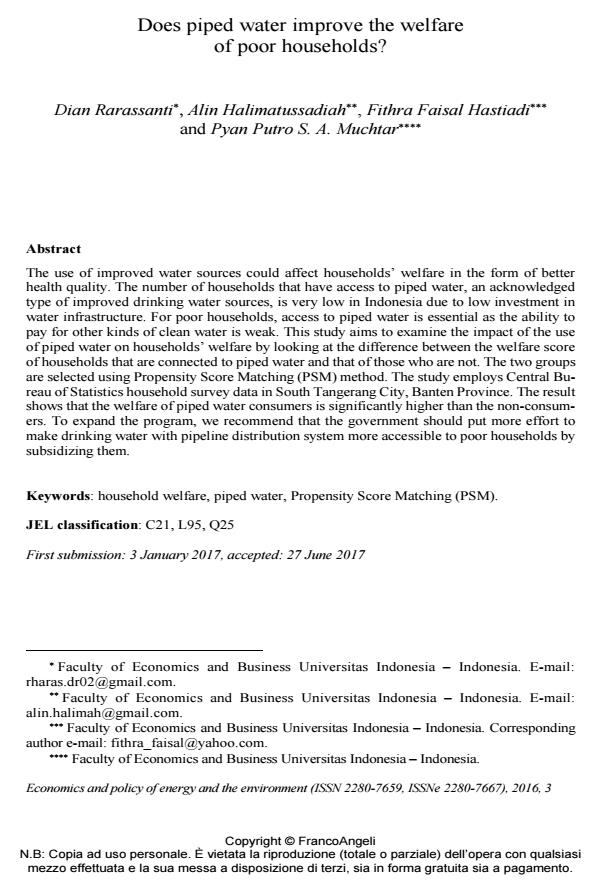Does piped water improve the welfare of poor households?
Titolo Rivista ECONOMICS AND POLICY OF ENERGY AND THE ENVIRONMENT
Autori/Curatori Dian Rarassanti, Alin Halimatussadiah, Fithra Faisal Hastiadi, Pyan Putro S. A. Muchtar
Anno di pubblicazione 2017 Fascicolo 2016/3 Lingua Inglese
Numero pagine 16 P. 119-134 Dimensione file 225 KB
DOI 10.3280/EFE2016-003010
Il DOI è il codice a barre della proprietà intellettuale: per saperne di più
clicca qui
Qui sotto puoi vedere in anteprima la prima pagina di questo articolo.
Se questo articolo ti interessa, lo puoi acquistare (e scaricare in formato pdf) seguendo le facili indicazioni per acquistare il download credit. Acquista Download Credits per scaricare questo Articolo in formato PDF

FrancoAngeli è membro della Publishers International Linking Association, Inc (PILA)associazione indipendente e non profit per facilitare (attraverso i servizi tecnologici implementati da CrossRef.org) l’accesso degli studiosi ai contenuti digitali nelle pubblicazioni professionali e scientifiche
The use of improved water sources could affect households’ welfare in the form of better health quality. The number of households that have access to piped water, an acknowledged type of improved drinking water sources, is very low in Indonesia due to low investment in water infrastructure. For poor households, access to piped water is essential as the ability to pay for other kinds of clean water is weak. This study aims to examine the impact of the use of piped water on households’ welfare by looking at the difference between the welfare score of households that are connected to piped water and that of those who are not. The two groups are selected using Propensity Score Matching (PSM) method. The study employs Central Bureau of Statistics household survey data in South Tangerang City, Banten Province. The result shows that the welfare of piped water consumers is significantly higher than the non-consumers. To expand the program, we recommend that the government should put more effort to make drinking water with pipeline distribution system more accessible to poor households by subsidizing them.
Keywords:Household welfare, piped water, Propensity Score Matching (PSM).
Jel codes:C21, L95, Q25
- Anderson E., Anglia E. and Anderson E. (2008). Economic Impacts of Access to Water and Sanitation in Ethiopia: Evidence from the Welfare Monitoring Surveys, No. 3. Addis Ababa.
- Bateman O. Massee, Smith S. and Roark P. (1993). A Comparison of The Health Effect of Water Suppply and Sanitation in Urban and Rural Areas of Five Afircan Countries. Washington D.C.
- Becker S.O. and Ichino A. (2002). Estimation of Average Treatment Effects Based on Propensity Scores. The Stata Journal, 2(4): 358-377.
- Blagbrough V. (2001). Looking Back: The Long-Term Impacts of Water and Sanitation Projects.
- Buck S., Au M. and David H. (2015). Measuring the Welfare Losses from Urban Water Supply Disruptions. Journal of the Association of Environmental and Resource Economists, 3(3): 743-778. DOI: 10.1086/687761
- Checkley W., Gilman R.H., Black R.E., Epstein L.D., Cabrera L. and Sterling C.R. (2004). Effect of Water and Sanitation on Childhood Health in a Poor Peruvian Peri-urban Community. The Lancet, 363: 112-118.
- Damin S. (1995). Transformasi Sumber Daya Manusia: Analisis Fungsi Pendidikan, Dinamika Prilaku Dan Kesejahteraan Manusia Indonesia Masa Depan. Bumi Aksara, Jakarta.
- Devoto B.F., Duflo E., Dupas P., Parienté W. and Pons V. (2012). Happiness on Tap: Piped Water Adoption in Urban Morocco. American Economic Journal: Economic Policy, 4(4): 68-99.
- Esrey S.A., Potash J.B., Roberts L. and Shiff C. (1991). Effects of improved water supply and sanitation on ascariasis, diarrhoea, dracunculiasis, hookworm infection, schistosomiasis, and trachoma. Bulletin of the World Health Organization, 69(5): 609-621.
- GLAAS (2014). Investing in Water and Sanitation: Increasing Access, Reducing Inequalities. Geneva.
- Hoddinott J. (1997). Water, Health, and Income: A Review, No. 25. Washington, D.C.
- HSBC (2012). Exploring the Links between Water and Economic Growth A Report Prepared for HSBC by Frontier Economics: Executive Summary. London.
- Hutton G., Haller L. and Bartram J. (2007). Global cost-benefit analysis of water supply and sanitation interventions. Journal of Water and Health, 5(4): 481-502.
- Jalan J. and Ravallion M. (2003). Does Piped Water Reduce Diarrhea for Children. Journal of Econometrics, 112(1): 157-173.
- Khander S.R., Koolwal G.B. and Samad H.A. (2010). Handbook on Impact Evaluation: Quantitative Methods and Practices. World Bank. DOI: 10.1596/978-0-8213-8028-4
- Maryono (2007). Menilai Aksesibilitas Air Minum (Studi Kasus: Aksesibilitas Air Bersih bagi Masyarakat Miskin di Semarang). Jurnal Presipitasi, 3(2): 86-92.
- Paranna A. (2003). Kualitas Air Dan Pilihan Penggunaan Air Tanah. Universitas Indonesia.
- Patunru A.A. (2015). Special Research Article on Health Policy Access to Safe Drinking Water and Sanitation in Indonesia. Asia & the Pacific Policy Studies, 2(2): 234-244.
- Roushdy R., Sieverding M. and Radwan H. (2012). The Impact of Water SUpply and Sanitation on Child Health: Evidence of Egypt, 25. New York.
- Samsuhadi (2009). Pemanfaatan Air Tanah Jakarta. Jurnal Air Indonesia, 5(1): 9-22.
- SIWI and WHO (2005). Making Water a Part of Economic Development: The Economic Benefits of Improved Water. Stockholm.
- Tsukada L.R. and Hailu D. (2016). The Impact of Piped Water Supply on Household Welfare, No. 46. Boschstraat.
- WHO and UNICEF (2008). Progress on Drinking Water and Sanitation. Geneva: WHO Press.
- WHO and UNICEF (2015). Progress on Drinking Water 2015 update and MDG Assessment. Geneva: WHO Press.
Dian Rarassanti, Alin Halimatussadiah, Fithra Faisal Hastiadi, Pyan Putro S. A. Muchtar, Does piped water improve the welfare of poor households? in "ECONOMICS AND POLICY OF ENERGY AND THE ENVIRONMENT" 3/2016, pp 119-134, DOI: 10.3280/EFE2016-003010